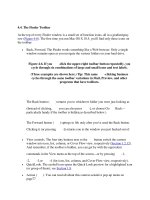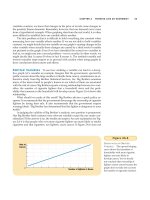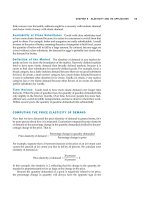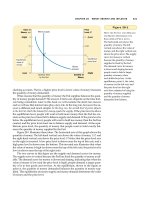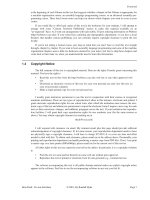Tài liệu The Art of the App Store ppt
Bạn đang xem bản rút gọn của tài liệu. Xem và tải ngay bản đầy đủ của tài liệu tại đây (10.32 MB, 308 trang )
www.it-ebooks.info
www.it-ebooks.info
THE ART OF THE APP STORE
INTRODUCTION xv
CHAPTER 1
A Brief History of Time intheAppStore 1
CHAPTER 2 Setting Your Goals, Costs, andExpectations 13
CHAPTER 3 Researching the App Store Market 33
CHAPTER 4 Knowing Your Customer 63
CHAPTER 5 Plotting the Stages of Development 93
CHAPTER 6 Guidelines and Expectations forDeveloping Your App 123
CHAPTER 7 Creating Free and Freemium Apps 145
CHAPTER 8 Creating Paid and Premium Apps 177
CHAPTER 9 Adopting Apple’s Approach 195
CHAPTER 10 Riding the Social Networking Wave 211
CHAPTER 11 Feedback, Maintaining, andScaling 243
APPENDIX A Reading List of RecommendedBooks 257
APPENDIX B Online Resources 261
INDEX 275
www.it-ebooks.info
www.it-ebooks.info
The Art of the App Store
THE BUSINESS OF APPLE DEVELOPMENT
Tyson McCa nn
www.it-ebooks.info
The Art of the App Store: The Business of Apple Development
Published by
John Wiley & Sons, Inc.
10475 Crosspoint Boulevard
Indianapolis, IN 46256
www.wiley.com
Copyright © 2012 by John Wiley & Sons, Inc., Indianapolis, Indiana
Published by John Wiley & Sons, Inc., Indianapolis, Indiana
Published simultaneously in Canada
ISBN: 978-0-470-95278-8
ISBN: 978-1-118-22112-9 (ebk)
ISBN: 978-1-118-23534-8 (ebk)
ISBN: 978-1-118-26007-4 (ebk)
Manufactured in the United States of America
10 9 8 7 6 5 4 3 2 1
No part of this publication may be reproduced, stored in a retrieval system or transmitted in any form or
by any means, electronic, mechanical, photocopying, recording, scanning or otherwise, except as permitted
under Sections 107 or 108 of the 1976 United States Copyright Act, without either the prior written permis-
sion of the Publisher, or authorization through payment of the appropriate per-copy fee to the Copyright
Clearance Center, 222 Rosewood Drive, Danvers, MA 01923, (978) 750-8400, fax (978) 646-8600.
Requests to the Publisher for permission should be addressed to the Permissions Department, John Wiley
& Sons, Inc., 111 River Street, Hoboken, NJ 07030, (201) 748-6011, fax (201) 748-6008, or online at
/>Limit of Liability/Disclaimer of Warranty: The publisher and the author make no representations or war-
ranties with respect to the accuracy or completeness of the contents of this work and specically disclaim
all warranties, including without limitation warranties of tness for a particular purpose. No warranty
may be created or extended by sales or promotional materials. The advice and strategies contained herein
may not be suitable for every situation. This work is sold with the understanding that the publisher is not
engaged in rendering legal, accounting, or other professional services. If professional assistance is required,
the services of a competent professional person should be sought. Neither the publisher nor the author shall
be liable for damages arising herefrom. The fact that an organization or Web site is referred to in this work
as a citation and/or a potential source of further information does not mean that the author or the publisher
endorses the information the organization or Web site may provide or recommendations it may make.
Further, readers should be aware that Internet Web sites listed in this work may have changed or disap-
peared between when this work was written and when it is read.
For general information on our other products and services please contact our Customer Care Department
within the United States at (877) 762-2974, outside the United States at (317) 572-3993 or fax (317)
572-4002.
Wiley publishes in a variety of print and electronic formats and by print-on-demand. Some material
included with standard print versions of this book may not be included in e-books or in print-on-demand. If
this book refers to media such as a CD or DVD that is not included in the version you purchased, you may
download this material at . For more information about Wiley prod-
ucts, visit www.wiley.com.
Library of Congress Control Number: 2011939653
Trademarks: Wiley, the Wiley logo, Wrox, the Wrox logo, Programmer to Programmer, and related trade
dress are trademarks or registered trademarks of John Wiley & Sons, Inc. and/or its afliates, in the United
States and other countries, and may not be used without written permission. Apple, iPad, iPhone, iPod, and
iTunes are registered trademarks of Apple, Inc. IOS is a registered trademark of Cisco Systems. All other
trademarks are the property of their respective owners. John Wiley & Sons, Inc., is not associated with any
product or vendor mentioned in this book.
www.it-ebooks.info
To CG, J, and L.
www.it-ebooks.info
ABOUT THE AUTHOR
TYSON MCCANN is a game designer, producer, user experience, and social media
consultant with experience at major game companies including Sega, 3DO, the
Tetris Company, Fisher-Price, and Funcom. His broad experience includes edu-
cational software, casual and social games, and hard-core video and computer
games on everything from mobile devices to current generation consoles and PC.
Along with design and production on a few iPhone titles, in 2010 he was part of
a team that released a top-grossing, multiple award-winning iPhone multiplayer
action game.
ABOUT THE TECHNICAL EDITOR
JOSH COLDIRON is a cross-media designer who has worked on several IOS games
across all apple mobile devices, including the “Hall of Fame” award-winning
“Archetype.” His experience ranges from producer and level design, to leading
quality assurance and localization. He has practiced successful use of social net-
working as a marketing tool for IOS apps, as well as for his own business. Before
IOS development, he was art director in the print eld for various publications.
He currently works alongside Villain developing new IOS titles.
www.it-ebooks.info
ACQUISITIONS EDITOR
Mary James
PROJECT EDITOR
Kevin Shafer
TECHNICAL EDITOR
Josh Coldiron
SENIOR PRODUCTION EDITOR
Debra Banninger
COPY EDITOR
Kim Cofer
EDITORIAL MANAGER
Mary Beth Wakefield
FREELANCER EDITORIAL MANAGER
Rosemarie Graham
ASSOCIATE DIRECTOR OF MARKETING
David Mayhew
MARKETING MANAGER
Ashley Zurcher
BUSINESS MANAGER
Amy Knies
PRODUCTION MANAGER
Tim Tate
VICE PRESIDENT AND
EXECUTIVEGROUPPUBLISHER
Richard Swadley
VICE PRESIDENT AND
EXECUTIVEPUBLISHER
Neil Edde
ASSOCIATE PUBLISHER
Jim Minatel
PROJECT COORDINATOR, COVER
Katie Crocker
COMPOSITOR
James D. Kramer,
Happenstance Type-O-Rama
PROOFREADER
Nancy Carrasco
INDEXER
Robert Swanson
COVER DESIGNER
Ryan Sneed
COVER IMAGE
© Brian Santa Maria / iStockPhoto
CREDITS
www.it-ebooks.info
ACKNOWLEDGMENTS
I AM VERY GRATEFUL to Kevin Shafer for his fantastic editorial assistance, compe-
tence and professionalism, as well as to Mary James, Mary Beth Wakeeld, and
all those involved at Wiley for this opportunity. To Josh Coldiron for keeping the
references to past projects in check and being a logic gatekeeper. To Dane Baker
of Villain for his reaching out and asking me to tag along on his company’s initial
whirlwind journey. To MunkyFun for having the skills to develop a hit iOS app
as if they’d been doing it for years. To developers, colleagues, and those I’ve been
fortunate enough to work with for helping me continue to grow in software devel-
opment, and as a professional. And innite thanks especially to my family and my
wife, Melissa, for being so patient and supportive. I owe you unconditionally,
big time.
www.it-ebooks.info
CONTENTS
INTRODUCTION xv
CHAPTE
R 1: A BR
IE
F HIST
O
RY OF T
I
M
E
I
N
T
H
EAPPS
TO
RE
1
Time in a Table 1
The Early App Store 5
Novel Uses of the Touch Screen 6
Simplicity Succeeds While Complexity Fails 8
The Modern App Store 9
The Slow March Toward Complex Apps 10
How Niches Have Changed from the Early App Store 10
Summary 11
CHAPTER 2: SETTING YOUR GOALS, COSTS, ANDEXPECTATIONS 13
Confronting the “Hero Inventor” Syndrome 13
Benefitting by Doing It Yourself 14
Outsourcing 15
Avoiding the Pitfalls of Going It Alone 20
Considering Your Fundamental Costs 23
Programming 24
Factoring in UI/UX for Game/App Design 25
Factoring in Art Design 26
Considering Your Optional Costs 26
Audio Costs 26
Special Eects Costs 27
Localization for Foreign Markets 27
Quality Assurance/Testing 28
Public Relations and Marketing 29
Advertising Costs 30
Managing Your Expectations 31
The App Store as a Crowded Zoo 31
Planning for Cost Overruns 32
Scheduling with an Iron Fist 32
Summary 32
CHAPTER 3: RESEARCHING THE APP STORE MARKET 33
Examining the Numbers and Trends 33
Making Decisions Based on Research 36
www.it-ebooks.info
x
CONTENTS
Opportunity Size: Is There a Hole in the Market? 37
Choosing Your Niche 38
Perform Due Diligence Early 39
Summary Decisions 40
Analyzing Successful Apps 41
Exploring Popular Features 48
Exploring Visual Styles 49
Exploring Social Integration 50
Exploring the iPhone Hall of Fame 51
Avoiding Pesky Ego Traps 51
Game Concepts: Old versus New 53
Analyzing Unsuccessful Apps 55
Learning from Other People’s Mistakes 57
Learning from Other People’s Complaints 58
Mixing and Matching 59
Borrowing Style and Functionality from Mainstream
Applications/Games (the Picasso Way) 59
Pulling Out Successful Features for a Twist 60
Summary 60
CHAPTER 4: KNOWING YOUR CUSTOMER 63
Understanding App Store Demographics 64
Casual and Traditional Gaming Pillars 65
iPhone Casual versus TraditionalCasual 68
Meeting Your Customer’s Expectations 68
Visual and Graphical Expectations 69
Gameplay and Feature Set Expectations 69
Competitive Feedback Research 91
Summary 91
CHAPTER 5: PLOTTING THE STAGES OF DEVELOPMENT 93
Leadership and Your Team 94
Assumptions about Your Role 95
Your Starting Lineup 95
A Controlling Idea to Kick Things O 98
Concept through Release 100
Maximizing Your App through Agile Development 101
Planning — Envisioning Your Vision 104
Scheduling 107
Production and Stages of Development 115
Coordinating Marketing 119
Summary 121
www.it-ebooks.info
xi
CONTENTS
CHAPTER 6: GUIDELINES AND
EX
PEC
T
ATI
O
N
S
FORD
EVE
LOP
IN
GY
O
UR APP
12
3
Potential Risk and Reward 124
Paid Apps Are Seen as WYSIWYG 124
What Incentives Can You Provide When Sales Dwindle? 124
Are You Planning on In-App Purchases? 124
Can You Go Free? 125
Like Winning the Lottery 125
Revenue Like a Rollercoaster 126
App Store Business Models 127
Free Apps 127
Paid App Revenue Models and Price Expectations 129
Creating for a Multitasking World 132
Understanding the Eects of Multitasking on the Brain 133
Seeing the Phone as the Ultimate Multitasking Tool 133
The Half-Second Window 133
Understanding Typical User Tendencies with Touch Screens 134
Building Initial Interactions That Meet the
“Half-Second Window” 134
Depicting the Physical World 136
Using Physical Metaphors to Delight Your Audience 136
Designer/Branding Exercise:
Creating Metaphors for Your App 139
Utilizing Physical Forces: Gravity, Weather, Objects 143
The Importance of Sound in Physical Metaphors 144
Summary 144
CHAPTER 7: CREATING FREE AND FREEMIUM APPS 145
App Revenue Terminology 146
Microtransaction 146
Downloadable Content (DLC) 146
Free App 148
Freemium App 148
In-App Purchase 149
Free-to-Play App (F2P) 149
Lite App 149
Long Tail Strategy 150
Business Reasons behind Revenue Models 150
Free App Considerations 150
Freemium App Considerations 151
Lite App Considerations 153
Considering Risks and Rewards 155
Free Apps 155
www.it-ebooks.info
xii
CONTENTS
Freemium Apps 156
Lite Apps 156
Minimizing Risk for Any App 157
How to Succeed with a Free App 157
Free Apps 157
Lite Apps 160
Supporting Your App with Ads 165
How to Succeed with a Freemium App 168
Microtransactions and the Long Tail 169
Viable Ways to Monetize 170
Implementing a Virtual Currency System 172
Succeeding with the Freemium Model 176
Summary 176
CHAPTER 8: CREATING PAID AND PREMIUM APPS 177
Business Reasons behind Revenue Models 178
Two Types of Paid Apps 178
Entertainment versus Practicality or Education in
PricePoint Determination 179
Non-Premium Paid App Considerations 180
Premium Paid App Considerations 181
Considering Risks and Rewards 183
Non-Premium Paid Apps 183
Premium Paid Apps 184
How to Succeed with Paid Apps 184
The Paid App Mentality 184
Integrating Your Lite Version 187
Adding In-App Purchases 192
Summary 193
CHAPTER 9: ADOPTING APPLE’S APPROACH 195
Infusing an Insane Amount of Care 196
Treating User Experience as King 197
The Little Things Matter… More Than You Think 200
Value-Added Benefits (GoFartherThanYouThinkYouShould) 202
Customer as King 203
Adapting Apps to iPad 204
Case Study: Tapbots 206
High-Contrast Branding 206
Refined, Responsive, Simplistic Interface 207
No Transitions 208
Standard Conventions 208
Summary 209
www.it-ebooks.info
xiii
CONTENTS
CHAPTER 10: RIDING THE SOCIAL NETWORKING WAVE 211
Fostering the Ultimate Viral Marketing: SocialNetworks 212
Integrating In-App Networks 212
Building Achievements, Medals, Badges, andOtherRewards 218
Taking Cues from Facebook 219
Everything Is More Fun with Friends 220
It’s All about Metrics — Tweak Values Early and Often 220
Ignoring Facebook Conventions 222
Waiting Is Not Fun 223
No Forced Friends, Please 223
Rewarding Users for Promoting Your App 224
Gifting with Virtual Objects, Free Stu 224
Providing Users with a Sense of Community 227
Social Interaction as Features 227
Features versus Extras 228
Setting the Stage for Users to Compete 228
Providing the Tools for Users to Connect 232
Implementing Facebook Connect and Twitter 232
Fostering Your In-App User Community 234
Maximizing Viral Channels 235
Summary 240
CHAPTER 11: FEEDBACK, MAINTAINING, ANDSCALING 243
Evaluating Feedback 244
Soft Launch Preparation 244
Main Launch Feedback 245
Taking the Good and the Bad 246
Converting Data into Actionables 247
Maintenance Isn’t Just Fixing, It’s Marketing 250
Customer Support Is Key 250
Timely Updates 253
Scaling 253
Releasing New Content 253
Building for Other Platforms 254
The Future of Your App 254
Summary 256
APPENDIX A: READING LIST OF RECOMMENDEDBOOKS 257
App Development 257
Business and Project Management 257
iOS Programming 258
www.it-ebooks.info
xiv
CONTENTS
Design and Art 258
Marketing 258
Creativity and Inspiration 259
APPENDIX B: ONLINE RESOURCES 261
Research and Metrics 261
App Store Metrics and Rankings 261
App Usage and Engagement Metrics 262
Website Metrics and SEO 262
Planning and Communicating 263
Outsourcing 263
Project Management 263
E-Mail, Video Conferencing, Chat, and Screen Sharing 265
Developing 265
iOS Development 265
Social Game Solutions 266
Brainstorming and Prototyping 267
Documentation 268
Cross-Platform Development 268
Royalty-Free Audio 269
Marketing 269
App News and Review Sites 269
Ad Networks and Aliates 270
Award Sites 271
Press Release Submission 271
E-Mail Marketing 272
Full-Featured Marketing Solutions 272
Social Media 272
Customer Support 274
INDEX 275
www.it-ebooks.info
INTRODUCTION
WITH ROUGHLY HALF A MILLION active apps available for download and a current
pace of 20,000 new apps approved every month (according to
148apps.biz), the
iOS App Store has been without doubt a phenomenal success. From its launch in
2008, it’s seen exponential growth both in revenue generated and apps created,
and it continues to flourish.
You may have heard the early success stories of lone programmers making thou-
sands per day in revenue off of experimental apps. From then on, it wasn’t long
before larger sums of money were being thrown at app development from more
major players and venture capitalists, and it’s been that way ever since.
Though the App Store is showing no signs of weakening, it is becoming increas-
ingly top-heavy. For example, depending on your niche, the top 20 percent of apps
may do well in terms of numbers of downloads, but as you’ll see later in the book,
after that, the numbers drop signicantly.
The type of success that many developers aspire to (such as the success of the
“Angry Birds” application) is relatively unique, but there is still great opportunity
in the App Store frontier, and lessons to be learned from both success stories and
failures. Trends are shifting greatly from old business models to new, and, in this
book, you will nd them covered in detail.
WHO THIS BOOK IS FOR
Because the App Store houses dozens of categories and hundreds of new apps each
day, the big question (especially for new or up-and-coming developers or publish-
ers) is how can I ensure my apps stand out from the competition and make a
prot? Consider this book a handy guide for nding the answer to that question.
You do not need a Harvard MBA to read this book — far from it, in fact. Although
this book is lled with statistics and some curves, they are all easily explained.
Business models are about pricing, marketing, and positioning your app within
its niche, something everyone will have some familiarity with. Whether you are a
developer, publisher, or entrepreneur trying your hand at iOS development, this
book will teach you the ins and outs of ensuring that your app has the best chance
at sitting at the top of your niche.
WHAT THIS BOOK COVERS
Although this book makes references to the current state of the App Store (some
of which will become outdated as the App Store evolves), it is designed to be read
as a business guide for nding your niche, assembling a team, developing, and
marketing an app at any time, now or in the future.
www.it-ebooks.info
xvi
INTRODUCTION
Here is a small checklist of some of the important topics covered:
Current and future trends in the App Store
Methods of competitive research
App development costs
App Store business models and customer expectations
Assembling a development team and outsourcing
The stages of app development (including soft launch and post release)
Marketing your app
Social network integration within your app (including Facebook, Twitter,
Game Center, and more)
Effective ways to maximize social media in your marketing campaign
Post-launch maintenance and support options
If any of these are of interest to you, then you should denitely be reading this book.
HOW THIS BOOK IS STRUCTURED
Though this book was designed to be read sequentially straight through — espe-
cially for the new developer or publisher — each chapter by itself covers a com-
plete aspect of development. So, by all means, you should feel free to skip around
as desired, depending on your current interests and stage of development.
If you’re either an experienced developer with an existing team, or already at some
stage of development on an app, you may still nd it useful to browse through
some of the chapters you already feel comfortable with, to nd potential addi-
tional tips and advice that may make development more efcient for your team.
Following are the topics covered in this book (in order of presentation):
Chapter 1 provides an overview of where the App Store currently is with
regard to trends and business models.
Chapter 2 provides outsourcing information and expectations for costs.
Chapters 3 and 4 go in-depth into methods of competitive research and
managing customer expectations.
Chapter 5 is all about the stages of development, as well as useful produc-
tion and project-management strategies.
Chapter 6 is an expectation checklist of sorts for things you should pay atten-
tion to in order to maximize user engagement once you’re ready to begin.
Chapters 7 and 8 go in-depth into the business models of free, “freemium,”
and premium apps, providing tips for lite versions, ads, and much more.
Chapter 9 covers some of the useful approaches and guidelines Apple has
developed for app and hardware design to achieve its highly respected sta-
tus. This chapter also covers design approaches to iPad app development.
www.it-ebooks.info
xvii
INTRODUCTION
Chapter 10 is all about social networking, from implementing Game Center
and other social networks, to Facebook Connect, to maximizing your viral
channels in your marketing campaign. It also covers the importance of metrics
and split testing. This is an important chapter not to be missed by anyone.
Chapter 11 covers soft-launch preparation and feedback, post-launch sup-
port, how to scale your app for updates, and even touches on cross-platform
support. At the end of the chapter, you will nd a great list of marketing and
promotion techniques.
To end the book are two appendixes. Appendix A focuses on recommended
reading, and Appendix B is a valuable online reference tool for nearly all
aspects of development.
WHAT YOU NEED TO USE THIS BOOK
This book can be read as a non-technical guide, without the need for supplemen-
tary software to get value from it. However, when you begin developing for iOS,
(iPhone, iPad, and so on), you will need a Mac, typically running the latest Mac
OS for the latest version of iOS (currently in iteration 5). Anything from a Mac
Mini to MacBook Pro will work.
If you’re just planning on testing or reviewing builds, and not being part of pro-
gramming, a Mac isn’t required, but you should eventually own one of the devices
your app is being planned for, so you can see for yourself how new versions of your
app are progressing prior to release.
You may also want to get started reading up on Apple’s Developer Portal (developer
.apple.com
), where Apple offers everything from helpful guides for getting started,
to downloads of the iOS Software Development Kit (SDK).
As well as reading up, if you’re sure you’ll be developing an app, be sure to enroll
early for the iOS Developer Program (
developer.apple.com/programs/ios/),
because this is where you will get access to the App Store for either yourself as an
individual developer, or your company, where you can add additional members
of your team.
CONVENTIONS
To help you get the most from the text and keep track of what’s happening, we’ve
used a number of conventions throughout the book.
The pencil icon indicates notes, tips, hints, tricks, and asides to
the current discussion.
As for styles in the text:
We highlight new terms and important words when we introduce them.
We show keyboard strokes like this: Ctrl+A.
www.it-ebooks.info
xviii
INTRODUCTION
We show lenames, URLs, and code within the text like so: persistence
.properties
.
We present code in two different ways:
We use a monofont type with no highlighting for most code examples.
We use bold to emphasize code that is particularly important in the
present context or to show changes from a previous code snippet.
ERRATA
We make every effort to ensure that there are no errors in the text or in the code.
However, no one is perfect, and mistakes do occur. If you nd an error in one
of our books, like a spelling mistake or faulty piece of code, we would be very
grateful for your feedback. By sending in errata, you may save another reader
hours of frustration, and at the same time, you will be helping us provide even
higher quality information.
To nd the errata page for this book, go to
www.wrox.com and locate the title
using the Search box or one of the title lists. Then, on the book details page, click
the Book Errata link. On this page, you can view all errata that has been submit-
ted for this book and posted by Wrox editors. A complete book list, including
links to each book’s errata, is also available at
www.wrox.com/misc-pages/
booklist.shtml
.
If you don’t spot “your” error on the Book Errata page, go to
www.wrox.com/
contact/techsupport.shtml
and complete the form there to send us the error
you have found. We’ll check the information and, if appropriate, post a message
to the book’s errata page and fix the problem in subsequent editions of the book.
Because many books have similar titles, you may nd it easiest to
search by ISBN; this book’s ISBN is 978-0-470-95278-8.
P2P.WROX.COM
For author and peer discussion, join the P2P forums at p2p.wrox.com. The forums
are a web-based system for you to post messages relating to Wrox books and related
technologies, and to interact with other readers and technology users. The forums
offer a subscription feature to e-mail you topics of interest of your choosing when
new posts are made to the forums. Wrox authors, editors, other industry experts,
and your fellow readers are present on these forums.
At , you will find a number of different forums that will
help you, not only as you read this book, but also as you develop your own appli-
cations. To join the forums, just follow these steps:
1. Go to p2p.wrox.com and click the Register link.
2. Read the terms of use and click Agree.
www.it-ebooks.info
xix
INTRODUCTION
3. Complete the required information to join, as well as any optional informa-
tion you wish to provide, and click Submit.
4. You will receive an e-mail with information describing how to verify your
account and complete the joining process.
You can read messages in the forums without joining P2P, but in
order to post your own messages, you must join.
Once you join, you can post new messages and respond to messages other users
post. You can read messages at any time on the Web. If you would like to have
new messages from a particular forum e-mailed to you, click the Subscribe to
this Forum icon by the forum name in the forum listing.
For more information about how to use the Wrox P2P, be sure to read the P2P
FAQs for answers to questions about how the forum software works, as well as
many common questions speci c to P2P and Wrox books. To read the FAQs,
click the FAQ link on any P2P page.
www.it-ebooks.info
www.it-ebooks.info
A Brief History of Time
intheAppStore
WHAT’S IN THIS CHAPTER?
Understanding the evolution that has led to the current
App Store market
Learning how four simple touch controls have led to a
large leap forward for usability
Finding out what’s needed for an app in today’s modern
App Store
On July 11, 2008, Apple’s App Store launched with roughly 550 apps for the
iPhone — in total. Today, the App Store has roughly 500,000 apps, and is seen
by savvy developers and entrepreneurs as a potentially very lucrative market that
has no intention of slowing down.
Assuming that you can make your app stand out from the other apps in your
niche (or even create a new one), and take advantage of the latest trends as they’re
really just taking shape (such as the social media wave that is discussed in Chapter
10), you have a good shot at launching a product that earns enough revenue to
make it worth developing.
Because the exact intent and goal of this book is to help you develop an app that
nds its audience in a competitive market, it makes sense to kick things off with
an introduction to how the App Store became what it is today. Thus, this chapter
enables you to see the trends that shape today’s App Store market.
TIME IN A TABLE
Table1-1 provides you with a concise view of the evolution of the App Store over
the past few years.
1
www.it-ebooks.info
2 | CHAPTER 1 A Brief History of time intHeAppstore
TABLE11: Evolution of the App Store
YEAR MONTH EVENTS
2008 July Over just the first three days, the number of avail-
able apps shot up more than 40 percent to 800.
The number of downloads in this time was 10 mil-
lion. In an early interview with the NY Times on
launch day, Steve Jobs was quoted as stating that
90 percent of apps would cost less than $9.99
(
www.nytimes.com/2008/07/10/technology/
personaltech/10apps.html). Little could he
guessjust how right he would be.
Early metrics by Medialets (www.medialets.com) indi-
cated that the average price for an app dropped from
$4.65 that initial Friday to $4.25 by Sunday, nearly 10
percent. Paid apps also saw a similar decrease. So, it
wasn’t just an influx of free apps that caused the swing,
but classic undercutting was taking place in a competi-
tive market. It was a trend that continues to this day.
Another interesting finding from the same report
showed another developing trend. Free apps were
garnering 25 percent more reviews than paid apps.
Not only that, reviews tended to be more positive,
by a quarter of a star. That’s nothing to sneeze at in
a 5-star rating system (especially considering that
Apple rounds the ratings to the nearest half percent).
August
According to Jobs in an August 2008 interview in The
Wall Street Journal, within one month, the number of
downloads reached 60 million, the top 10 developers
earned an amazing $9 million, and the total app receipts
were $21 million (
/>SB12184234 1491928977.html).
The speed at which the early App Store was grow-
ing, its software being adopted, how well it was being
received by users, and the iOS being developed for,
were phenomenal. That said, it wasn’t without its
launch problems.
Soon after launch, Macworld interviewed early devel-
opers who had a few quibbles with the system. In
particular, they claimed there was not a finite reason-
ing method for approving apps, and that their ability
to adjust quickly to market fluctuations was dimin-
ished because of Apple’s monthly (and not real-time)
sales reports.
www.it-ebooks.info
Time in a Table | 3
YEAR MONTH EVENTS
September Despite any negative feedback, there was no slow-
ing down. In this month, Apple reached 100,000
downloads with more than 3,000 apps available for
download. In addition, Apple maintained Jobs’ launch
price point of 90 percent of the apps costing less
than the $10 barrier.
October
During the late part of October, the number of down-
loads (200,000) and the number of apps available
(7,500) nearly doubled from the September totals.
2009 April
In early 2009, the App Store reached the half million
download barrier and had more than 15,000 apps. On
April 23, 2009, the 1 billionth download took place, while
at the time 35,000 apps were available in 19 categories.
According to Fiercedeveloper.com, a researcher
broke down early iPhone download use and found that
nearly two-thirds of all iPhone users downloaded at
least 16 to 20 apps. That’s a huge adoption rate.
July On the one-year anniversary of the App Store, 1.5
billion downloads had been recorded from both
iPhone and iPod Touch (iPad came out in April, 2010),
with more than 65,000 apps, and more than 100,000
developers signed up for Apple’s developer program.
September Apple reaches the 2 billion download mark with more
than 85,000 apps available.
November
Along with more than 100,000 apps now available in
the App Store, Pinch Media (who created software for
app developers that, at the time, extrapolated from
more than 10 percent of all downloads) released some
interesting findings. The ratio of paid to free apps was
9,300 to 71,000. Further, it found that the average app
in the top 10 percent received roughly 75,000 down-
loads, while the average app in the next 10 percent
only got a little over 9,000, and from there the next
10 percent averaged just below 4,000. Pinch Media
stated that more than 50 percent of all paid apps were
downloaded less than 1,000 times. This equates to a
very top-heavy market with “successful” apps being in
the minority.
continues
www.it-ebooks.info



